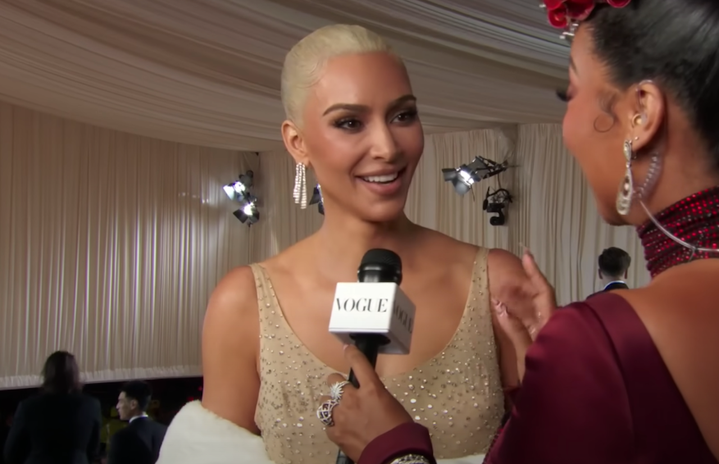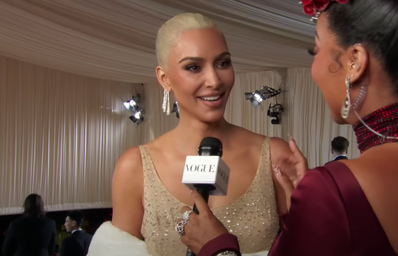On May 2, Kim Kardashian’s Met Gala dress caused a stir online. The reality star showed up in the iconic dress Marilyn Monroe wore in 1962 while singing “Happy Birthday” to then-president John F. Kennedy. Just as when it comes to any move the Kardashians make, people had plenty to say online, whether it had to do with the lack of consideration for the theme (Gilded Glamour, specifically referring to the Gilded Age of 1870 to 1890 in America), the horror of fashion conservators at someone wearing a piece of history, and — perhaps loudest of all — that the dress just didn’t fit Kim.
In an interview with Vogue, Kim shared that she had lost 16 pounds in just three weeks in order to fit into the dress, though later video footage revealed the dress still wouldn’t zip over her butt and she had to cover it with a coat on the red carpet. “I would wear a sauna suit twice a day, run on the treadmill, completely cut out all sugar and all carbs, and just eat the cleanest veggies and protein,” Kim told Vogue. “I didn’t starve myself, but I was so strict.”
Celebrities like Lili Reinhart reacted with outrage at the news of Kim’s diet and glamorization of weight loss. “To openly admit to starving yourself for the sake of the Met Gala. When you know very well that millions of young men and women are looking up to you and listening to your every word. The ignorance is other-worldly disgusting,” Lili wrote in an Instagram story.
Kim’s trainer, Don-A-Matrix, defended the rapid weight loss in an interview with TMZ, saying, “She’s been on a real balanced diet and at times she wouldn’t eat as much, but then the second thing was she went to the gym and put the work in. It’s possible to lose 20 pounds in a healthy way.”
Kim’s and her trainer’s comments follow a societal trend of working to fit your clothes, rather than simply getting clothes that fit you. Many women keep “goal weight” or “skinny” clothes in their closet that don’t fit, with the hope that they one day might. But nutritionists have pointed out that this mindset is unhealthy, despite what Don-A-Matrix might claim, especially when weight loss happens in such a short period of time. Crash dieting can weaken your immune system, trigger heart issues, and have other negative health impacts, according to Cosmopolitan.
Plus, even if you think working towards fitting into a smaller outfit should be a source of inspiration, Livestrong points out that hanging on to “goal weight clothes” can promote dangerous behaviors, like disordered eating, excessive exercise, or self-critical thinking patterns. It makes us view our bodies as problems to be fixed, rather than an accepted reality like when you buy or wear clothes that actually fit you.
Clothes not fitting has also become a relevant topic of discussion due to the COVID-19 pandemic. The American Psychological Association’s 2020 “Stress In America” report found that 42% of surveyed American adults had gained more weight than intended during the pandemic, with an average of 29 pounds. Simply put, you can’t blame yourself for not fitting into a certain garment. It does not mean that you’ve failed at a certain goal or that you’re somehow incapable of being stylish. Weight fluctuations are natural and common, especially during a time of such turbulence and stress (stress can cause weight gain through rises in the hormone cortisol).
By not treating smaller sizes as a goal for yourself, you’re giving yourself a sign of acceptance of your body as it is instead of treating it as though it’s in a transitory state. Not only skinny girls can be fashionable; anyone can and should feel great in their clothes at any size. Even Kim wore a replica of the infamous dress that actually fit her once she was off the red carpet. Why not wear that one for the photos as well? What is gained by squeezing ourselves into too-small outfits in the hopes that we’re doing our appearances and our health a service?
Of course, the onus isn’t all on us individually to break this stereotype. According to Statista, the average American woman is now considered plus-size, but the clothing industry still rarely has the same options for those above a size 12 and those below it. Many women may not have as much freedom to simply go out and fill their closet with clothes in their size that they feel great in, because that is a privilege that has not yet been made universal. The idea of “goal weight clothes” is reinforced by an industry that upholds thinner sizes as the ideal, and while individual women can do their best to make individual choices about their wardrobe, retailers and designers also need to step up and make the industry more inclusive for everyone.
You only have one body; whatever size it may be, it’s still yours. We shouldn’t give into the pressure to conform to a beauty standard that doesn’t have our best interests at heart. Clothing should be comfortable, functional, and empowering. And we should be wearing them; we shouldn’t let them wear us.


